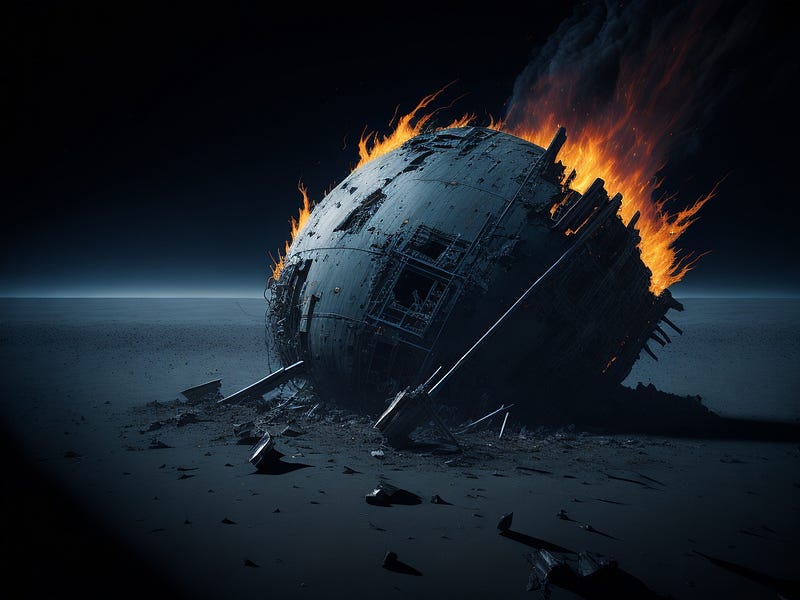Luna 25: Russia's Ambitious Moon Mission Ends in Disaster
Written on
Chapter 1: The Ambition Behind Luna 25
Russia launched the Luna 25 mission with the intent of showcasing its strength and technological capabilities. This initiative was seen as an attempt to prove that the country could conduct significant space missions independently, without needing collaboration with Western nations. However, the reality soon revealed that the grand announcements were not backed by solid execution. Communication was lost with the Luna 25 lander on Saturday, August 19, just two days prior to its scheduled landing.

On that fateful day, flight controllers experienced a loss of contact with the Luna 25 lander, which had launched on August 10. The malfunction occurred during crucial orbital maneuvers aimed at achieving a soft landing near the Moon's southern pole. This raises the question: does this mark the end of Russia's aspirations for renewed space prominence? The history of this mission suggests that while the Russian bear intended to make a powerful statement, it ended up producing a mere whisper.
Section 1.1: The Long Journey to Luna 25
It's important to recognize that the Luna 25 project dates back 25 years. Originally conceived in 1998, the mission faced multiple delays, with initial launch dates set for 2012, then pushed to 2014, and eventually further postponed to 2017.

In a surprising turn of events, Roscosmos, the Russian space agency, revived the mission in 2022, coinciding with geopolitical tensions following Russia's invasion of Ukraine. This revival came at a time when the European Space Agency had halted its collaborative efforts with Roscosmos due to sanctions. The head of Roscosmos even hinted at separating Russian modules from the International Space Station, further straining international relations.
With this backdrop, Putin turned to China, proposing a joint endeavor to establish a research base at the Moon's southern pole, a region also targeted by NASA, ESA, JAXA, and other agencies as part of the Artemis program.
Subsection 1.1.1: Launch Challenges
The launch of Luna 25 itself was not without its controversies. Instead of being launched from the traditional Baikonur spaceport, it took off from the newer Vostochny Cosmodrome, located in eastern Russia, just 100 km from the Chinese border. This decision highlighted Russia's shifting priorities.
On August 11, 2023, the lander was successfully placed atop a Soyuz 2.1b rocket. However, just days before the launch, reports emerged that residents in a nearby city were evacuated due to concerns about the rocket's auxiliary stages potentially falling in populated areas. This sparked alarm, as launches should be conducted in a manner that safeguards civilian lives, particularly when dealing with powerful rockets exceeding 50 meters in height.
Luna 25's mission was launched with high hopes. After a successful launch, it became the first Russian lunar probe in 47 years, sending back initial images, including a "selfie" with the Moon. The journey to lunar orbit took five days, but unfortunately, one of the planned maneuvers misdirected the probe, leading to its crash landing.
The onboard radar, crucial for a successful soft landing, experienced issues. This radar was meant to replace a camera that European partners were supposed to provide prior to the conflict in Ukraine. Following the crash, Roscosmos initiated an investigation to uncover the reasons behind this unexpected failure, which has cast doubt on future missions such as Luna 26 and 27.
Chapter 2: The Global Lunar Race
Amidst these setbacks, other countries are advancing in the lunar race. On August 23, India’s Chandrayaan-3 lander attempted a lunar landing. Should it succeed, India would join an exclusive group of nations that have successfully landed on the Moon, which includes Russia, the USA, and China.
Meanwhile, China's Yutu-2 rover continues to explore the Moon's far side, mapping its surface using sophisticated instruments like the Lunar Penetrating Radar. Clearly, the lunar competition is thriving, yet despite its ambitious announcements, Russia appears to be falling behind in this critical arena.
2025 Climate Catastrophe: The Shocking Collapse of the Gulf Stream in the Atlantic
The Gulf Stream, also referred to as the Atlantic Meridional Overturning Circulation (AMOC), plays a vital role in regulating the climate in the region...
Attention all readers!
As creators on Medium.com, we often receive minimal compensation for our efforts. If you find my work valuable, please consider supporting me on my “Buy Me a Coffee” page. Your contributions can make a significant difference in my ability to produce quality content. Thank you for your support!

